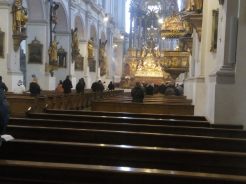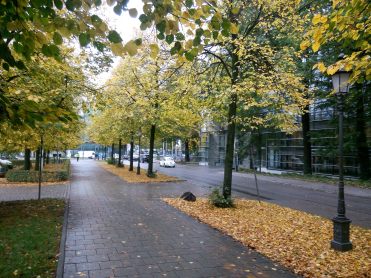The Bavarian capital city was the first city I visited in Germany in my trip. I had a rough idea of places to visit in Munich based on a blog I have read. I went to Marienplatz around 8am but most of places I wanted to visit were closed. I walked around the city taking photos and selfies. After
roaming for around 1 hour I visited Peterskirche (St. Peter’s Church) at Rindermarket. Theis 13th century church has a dome which is accessible to public. Climbing the 306 steps up the tower to the 56 meter high platform gives a beautiful panoramic view of the city. From there I proceeded to the Viktualienmarkt market which in an open-air market known as the “stomach of Munich”. The city’s market streets are famous for sausages and I purchased sausages from here. After recharging myself with different Bavarian delicacies I moved on see the Gothic hall-type church, Heiliggesitkirche (Church of the Holy Ghost).
Slowly mild precipitation started and temperature started to drop. Then I went back to the Marienplatz city center. Marienplatz is the major historic and scenic square of Altstadt (the Old Town. I was in time for 11 am show of Glockenspeil (carillion) on the 8.5m central spire of Neues Rathaus (New Town Hall). The Rathaus-Glockenspiel of Munich consists of 43 bells and 32 life-sized figures. The top half of the Glockenspiel tells the story of the marriage of the local Duke Wilhelm V (who also founded the world famous Hofbräuhaus) to Renata of Lorraine. In honour of the happy couple there is a joust with life-sized knights on horseback representing Bavaria (in white and blue) and Lothringen (in red and white) and the Bavarian knight wins every time, of course. This is then followed by the bottom half and second story: Schäfflertanz (the coopers’ dance). According to myth, 1517 was a year of plague in Munich. The coopers are said to have danced through the streets to bring fresh vitality to fearful dispositions. The coopers remained loyal to the duke, and their dance came to symbolize perseverance and loyalty to authority through difficult times. (Video: Link1, Link 2). The city tower provides another panoramic view of city. The Altes Rathaus (Old Town Hall) stands nearby to the New Town hall with a plain Gothic tower.
After enjoying the architectural beauty of the city I decided to visit Englischer Garten (English Garden). Thanks to Elector Carl Theodor who ordered to establish this and Benjamin Thompson who designed this urban park along the Isar River. The paths within this oasis piddle around in dark stands of mature oak and maple before emerging into sunlit meadows of lush grass. Kleinhesseloher See (a lovely lake at the centre of the park), Monopteros (a small Greek temple whose ledges are often knee-to-knee with dangling legs belonging to people admiring the view of the Munich skyline) and Japanisches Teehaus (built for the 1972 Olympics by an idyllic duck pond) add beauty to this marvel. I spend most of the afternoon in the sprawling English Garden. But once it started to rain, the temperature started to drop and I started feeling cold. I left the garden to a shopping street adjacent to Marienplatz where I bought a jacket without which I would have freeze to death without completing the rest of trip. The Bavaria capital had very few skyscrapers but most of buildings stands for specific architectural beauty. This is the first foreign city I have visited. I felt a special attachment with the München city compared to other German cities.












Pingback: A trip to Germany and Austria. | My travel blog